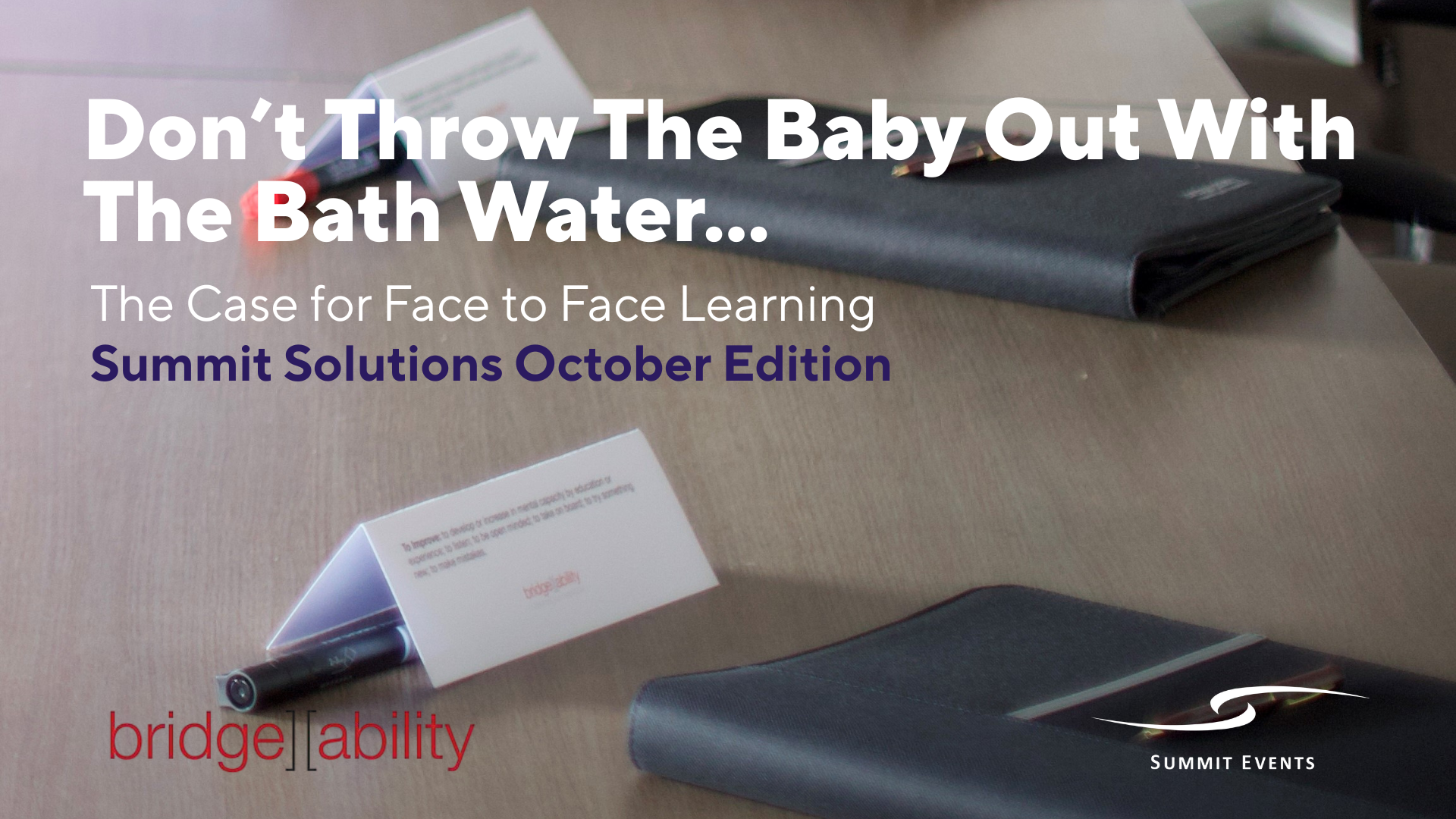
Don’t Throw The Baby Out With The Bath Water...
In this month’s edition of Summit Solutions, Bridgeability makes a strong case for the lasting value of face-to-face learning - highlighting how in-person experiences drive motivation, connection, and real skill development in ways virtual formats can’t always replicate.
The ongoing UK Covid-19 enquiry has recently turned its attention to education and the impact on those children who found themselves learning virtually for a large amount of the lockdown period. Against this backdrop it would appear to be an appropriate time to revisit face to face (F2F) learning and the advantages of a more traditional approach.
Remote working has delivered a number of enormous benefits to the world of learning and development. Much has been made of employees’ better use of time and ability to chose when they learn best. Approaches to learning can be tailored, or in many cases, bespoke to an individual or team’s requirements. The challenge with embracing the (relatively) ‘new’, is that the ‘old’ can become discarded as part of the process.
Whilst blended learning does offer many of the benefits of F2F, it is when F2F operates in isolation that its real value is discovered; think of the efforts made by parents to get their child into a school that offers a low student to teacher ratio. The case for F2F learning is compelling and should be read with the view that new is not always better.
Experiential Learning and Personal Feedback. Learning by doing is extremely powerful. It allows learners to create concrete experience and memories that enhance personal reflection and analysis. In turn this gives learners the opportunity to create their own approach to challenges based upon what they have undergone first-hand, rather than using the experience of others. Field trips, project work and case studies all provide excellent vehicles for ‘doing’ and giving the opportunity synthesise new approaches to any challenge. Experience also furnishes the learner with a multitude of options, thus giving inherent flexibility when problem solving and avoiding the need for a ‘playbook’ response.
Hands On. Many skills can only be learnt through hands on experience. Indeed much (cognitive) trust is placed in leaders with first hand experience. Think of the immortal question of whether or not an effective football manager must have had a playing career in order to get the best from their players. Leaders without first hand experience are more likely to be seen as incomplete due to their lack of ‘pitch time’.
Interaction and Networking. Being there, alongside others, provides an excellent opportunity for networking. This is challenging in a virtual environment, even when an online session is live. F2F learning gives participants the opportunity to interact with peers, colleagues and industry experts. All proffering differing views and sharing myriad experiences and challenges. Further, it creates an environment in which conversations have the best opportunity to flourish.
Motivation and Accountability. Operating alongside peers and colleagues brings with it a sense of having to deliver and the jeopardy of letting down the team. A group task in the F2F environment requires participants to deliver on their commitments. Therefore learners are more likely to deliver when procrastination and long-windedness are less readily available than they might be in the virtual world.
Structure. The benefits of this are twofold. First, there is the physical environment that learners are placed in, which has the ability to take them away from the distractions of a remote session, focussing them on the on task at hand and increasing levels of concentration. Secondly, there is the rigour of the formal structure of a F2F session; defined timings and location require students to be disciplined in the their approach to learning and to be cognisant of the foibles of learning alongside others.
Professional Skills. There is no denying that online learning offers an excellent way of sharing information. However, F2F learning is better able to develop those skills that might not be easily captured in a list of programme objectives. Leadership, teamwork, communication and emotional intelligence are all better understood when experienced first hand and in person. Moreover, in the real world, course designers can create pressure and induce stress, giving leaners the opportunity to develop rapid thinking and decision making skills. Pressure and stress can be delivered through simulation, although this can appear formulaic and lacking in dynamism; the human element adds a greater degree of unpredictability.
Conclusion. As the educational landscape continues to evolve so must our views of how best to impart information to learners in all areas. Although a mix of online and F2F learning is probably the best solution for most, the case for F2F learning remains very strong. Whilst many of its benefits are apparent, the broader range of positive aspects are perhaps less obvious. We operate best in groups, drawing positive outcomes from collective activity. As the pandemic and its associated lockdowns demonstrated, isolation can be a negative experience for many people. Whilst not solely a product of online learning, the impact upon those (of school age) whose education was affected by lockdown will continue for years to come.


